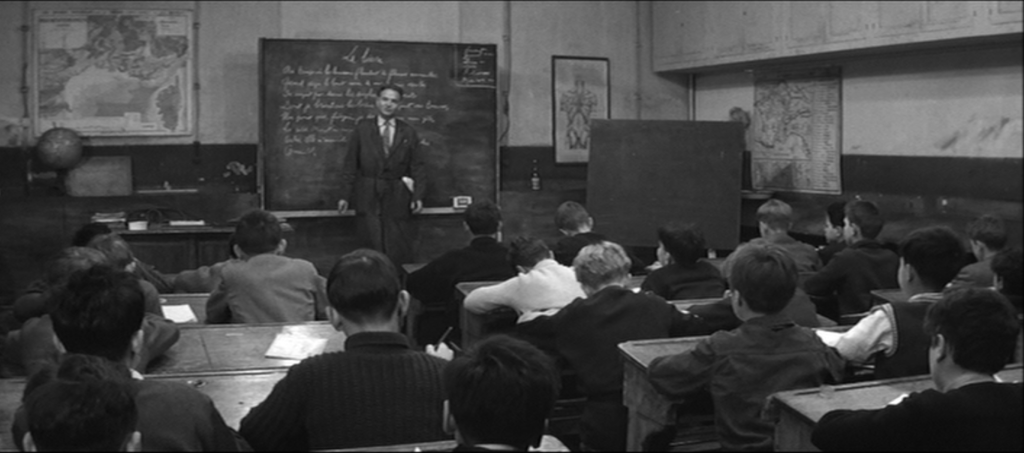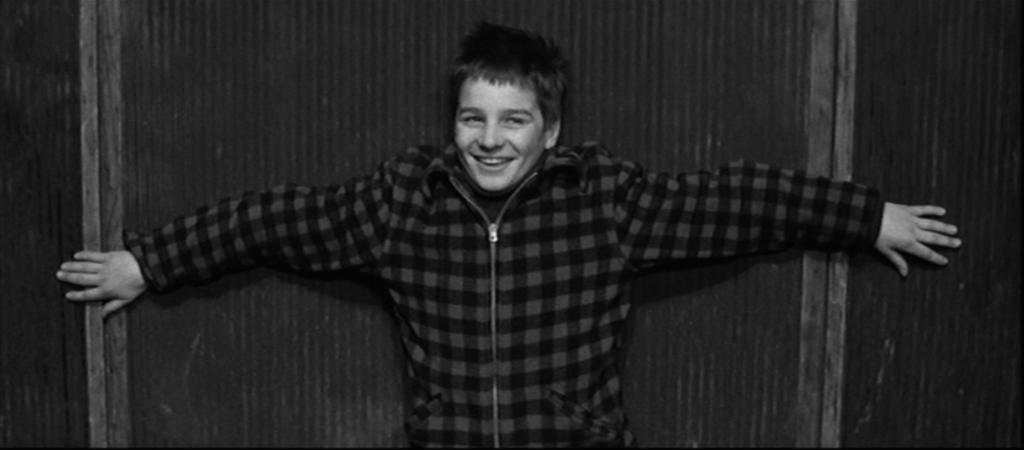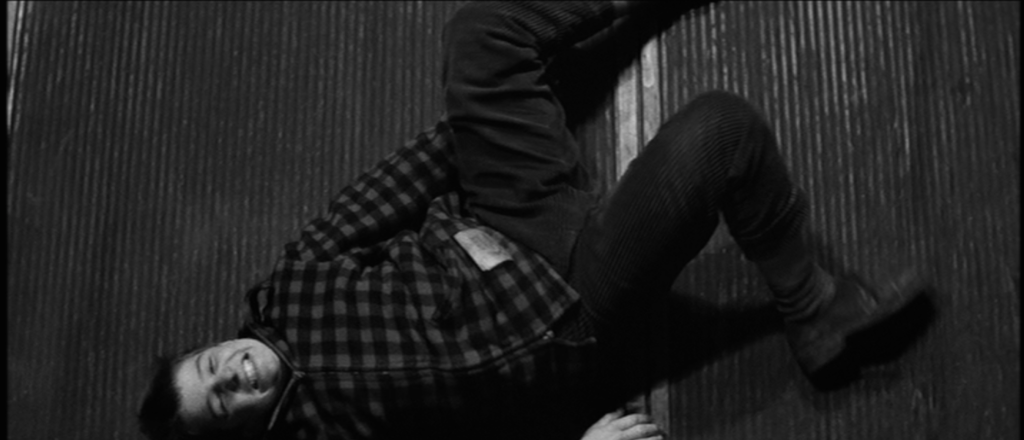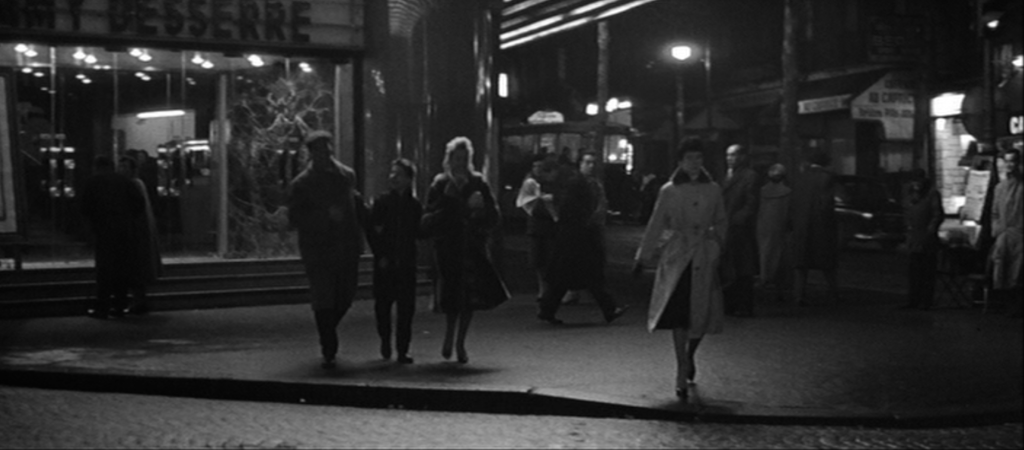Teaching The 400 Blows
Kristi McKim
I love introducing students to François Truffaut’s early writings and films. How quickly students become enchanted with Truffaut’s earnest and passionate manifesto-like celebrations of subjectivity and love. How contagiously I find Truffaut’s zeal infusing my own teaching, as his energetic criticism and films easily appeal to students and incite my own kinetic pedagogy. Teaching The 400 Blows (France, Francois Truffaut, 1959) enlivens the classroom; Roland Barthes claims that a photograph “animates me, and I animate it… this is what creates every adventure,” and this film especially brings such reciprocity to mind within the context of teaching film.[1] The film’s portrayal of a learning institution serves as a cri de coeur for me as a film teacher, reminded of the value of engaging with my students, of privileging an intimate and earnest pedagogy, of realizing that any “teaching” that happens one-sidedly hasn’t worked. The 400 Blows’ interest in including us[2] influences my own teaching, as it calls me to engage my students with a discussion as vibrant and dynamic as Antoine’s (Jean-Pierre Léaud) and René’s (Patrick Auffay) rule-breaking fun in the city. Just as Truffaut’s scathing film criticism raises the stakes for what his eventual films might become, so too does his 400 Blows lay down the gauntlet for what a film classroom ought be (I work to avoid my classroom hypocritically resembling the film’s own unproductive school environment!).

Figure 1: “What a class this year!,” Antoine’s authoritarian teacher (Guy Decomble) impatiently derides his disinterested students, as The 400 Blows raises the stakes for what an impassioned learning environment, by comparison, might be.
In ways that have been well-rehearsed in Truffaut scholarship, an idealization of movie-going prevails within his oeuvre; yet teaching The 400 Blows reminds me of how the space of the film classroom might also be engaged as a site of idealization. The 400 Blows—a film about (the transgression of) structures, limits, rules, and norms—gives rise to an invigorated film classroom. It offers a method and site of teaching that outshines the strictures of rote learning and champions the pleasures of passionate and intellectual engagement with objects of love. Though 400 Blows celebrates experience beyond an educational institution, it lends itself beautifully to a pedagogy that inhabits this glee, harnesses its whimsy, and forces our mindfulness of the limits and possibilities of our own thinking and becoming.
Vicky Lebeau writes that “Truffaut’s camera is on the side of the child, his face, his gestures, the tragi-comedy of his powerless, but still powerful, modes of being in an adult world.”[3] In The 400 Blows, we know of Antoine’s good intentions to return the stolen typewriter, for example, and the film continually stretches the gap between the adults’ perception of Antoine and our own. Antoine tries, the film keeps telling and showing us, though the other characters don’t register his effort so sympathetically. No adult sees Antoine; and nobody, according to autobiographical and biographical material, saw young François Truffaut except for André Bazin, who helped Truffaut to grasp how a youthful cinephilia could gain traction (and a mischievous past could be transformed) by writing for Cahiers du Cinéma. As the audience looks kindly toward Antoine, we’re asked to see as if André Bazin, our generous perception and withheld judgment a corollary to Bazin’s own. And so the film invites us to delight in the rapscallion adventures of a young misfit, to smile warmly and forgive his mistakes, to empathize with him all the while that we care for him, our Antoine at once Chaplin and Keaton, inspiring care and concern, admiration and identification. Teaching the film to college-age students helps to bridge and bolster these students’ own coming of age, as they navigate what it means to act responsibility for themselves and for others.
I teach The 400 Blows in both “Introduction to Film” and also “French New Wave”; in “Intro,” this film—accompanied by an excellent essay, “Youth and Entrapment in the French New Wave,” by Alastair Phillips—falls toward the semester’s end, between Bicycle Thieves (Vittorio de Sica, 1948) and the final screening of the semester, often Katia Lund’s and Fernando Meirelles’ City of God (2003).[4] In “French New Wave,” The 400 Blows stands as our third feature screening of the semester, following La Pointe Courte (Agnès Varda, 1955) and Elevator to the Gallows (Louis Malle, 1958). The accompanying readings include the Truffaut chapter of Richard Neupert’s History of French New Wave, excerpts from Annette Insdorf’s monograph on Truffaut, and writings by Truffaut, Alexandre Astruc, Antoine de Baecque, and Serge Toubiana.[5] In “Intro,” Phillips’ essay models how close formalist study might ripple outward into additional sequences and grander claims about how film makes visible broader intangible categories (e.g. freedom, youth, age, spontaneity, history, movement). These abstract qualities of stasis and movement, of freedom and constraint, of youth and age, of possibility and limits, further present a scaffolding to encounter many films and theories (e.g. Laura Mulvey’s Death 24x a Second).[6] In other classes and with regard to other films, I similarly ask questions about where protagonists seem or look most possible, about where and how the film feels most free, about where joy or pain becomes most palpable; teaching this film thus informs my work as a film professor more generally.
In both classes, I privilege the moments of self-reflexivity that teach and engage, giving forth to a new kind of subjectivity with film proper—a connection with the art itself—instead of strictly with character or artist. I begin with Les Mistons (Truffaut, 1957), as the short film’s concentration of joy and melancholia, of youth and longing, of love and death, of subjectivity and self-reflexivity offers a brilliant spectatorial adventure in preparing for Truffaut’s first feature. With particular attention to Les Mistons’ opening scene, I quote Charles Taylor’s claim that “Truffaut’s films made you feel as if the sun were singing to you,” and my utterance of this passage—usually typed into a slide, such that I can gesture towards the words themselves—makes me smile, makes my students smile, as we discuss the illumination and idealization that such a scene yields.[7] Les Mistons’ privileging of children’s point-of-view (here, rendered wistfully from the vantage point of a nostalgic adult), its rupturing continuity to collapse rather than stretch spectatorial distance, and its self-aware shifts between youth and age, love and death, idealization and fetishization: exploring these concepts within this short film prepares students for the longer and more challenging 400 Blows.
I begin each 400 Blows discussion by lingering on its dedication to André Bazin, an opportunity to reiterate Bazin’s influence upon Truffaut, whose foreword to What is Cinema, vol. 2 regularly floors me and my students in its generosity and lyricism.[8] That Bazin died on Truffaut’s first night of shooting The 400 Blows casts an elegiac mood upon the film. Thinking about Bazin from the start of class discussion reminds students of Truffaut’s own gratitude as a vulnerable child, an impassioned critic, a new director, and an adopted son. Furthermore, privileging Truffaut’s gratitude helps students to appreciate his earnestness (and also the mythical timing of his life’s events) from the outset.
I then jump to a progression of scenes around twenty minutes into the film (19:43), where we can see Antoine’s torn pajamas, his stifling home and score-less interior family drama, abruptly cut by the click of the door as he rushes outside. Of this scene, Phillips writes: “Truffaut contrasts the claustrophobic kitchen with the liberty and promise of the surrounding neighborhood streets.”[9] The scene vividly confirms for students the power of stylistic evocation, as interiors look dramatically different from the film’s exteriors. We build upon Phillips’ claims about this contrast, amplified with the distinct “click,” as Antoine pulls closed his apartment door and exits his home. One fast beat after the click, a joyful non-diegetic score overtakes Antoine’s outdoor experience, and it’s almost too clear—too easy, though also easy to overlook—this striking contrast between the enclosed airless family interior and the wide-open, possibility-filled exterior. I play and replay this scene, such that students can hear and appreciate the “buoyant and jaunty music [that] underscores a sense of improvised pleasure and creative freedom away from the confines of the classroom.”[10] Once outdoors, Antoine meets up with the confident René, who initiates him into school-skipping rituals. As many scholars and critics have noted, their rule-breaking exuberance matches Truffaut’s own, as successive shots wildly violate screen direction. In the classroom, I play this scene multiple times, and I linger on the swish pan that transports the boys across the street. I pause, say animatedly “wow, what just happened?” and replay, such that students can see for themselves what these broken continuity rules entail. I cannot teach this scene without physically moving my own body about the classroom, as I point out with exhilaration the mismatched screen directions that convey Antoine’s own discovery.
Though students can sense that something strange and exciting happens in these cuts, the replaying gives us time to grasp the extent to which the film here conceives of film as a magical transporting device, a glorious example of the film’s self-reflexivity that yields subjectivity. Though students can independently read that “The youthfulness of the action within the narrative is being inscribed within a mise-en-scène of matching invention and vigor,”[11] I’ve found that taking time to privilege these examples within our own film classroom transforms our very learning space, as our classroom becomes more cinema-like for the exuberance the film invites us to share.
The subsequent rotor scene introduces additional rules to transgress, as laws of gravity yield pleasure through their harnessing and subversion. With each semester of teaching this sequence, I increasingly appreciate the tender subtleties of Leaud’s expressions: how Antoine coolly struggles to appear non-plussed, though the ride moves him physically and emotionally, as some kind of surprising and smile-creeping pleasure softly reveals itself in his facial features. In addition to privileging multiple points-of-view (seeing Antoine, seeing Antoine’s blurred view of René), I further press students to unpack the significance of rotor’s zoetrope-like shape as the site within which Truffaut makes his own directorial cameo.
Dudley Andrew reads this scene as Leaud “[i]ncarnating Doinel but being himself…This boy—not yet an actor—spread-eagled as a spectacle before us, seems pinned and powerless, yet exhibits pure sensation on a ride that spins like a zoetrope as it animates him.”[12] Phillips claims that “Through its detailed investigation of Antoine’s face and gestures, the sequence prioritizes intimate dramatic visual experience over crafted verbal interaction.”[13] I ask students how they read “Antoine’s face and gestures,” and we move through this sequence frame-by-frame, pausing and describing not only the subtle changes in his expression but also how these changes cue our shifting feelings for and with Antoine. Through studying this scene in great detail, I’ve discovered my own tenderness for the film, a passionate appreciation for the film’s gentle rendering of subtleties, as Antoine works through a range of expressions—and by extension ages——by definition unreadable. Framing this scene within a film classroom not only unpacks its “pure sensation” and “intimate dramatic visual experience” but also yokes such intense feeling—of Antoine’s in riding, of ours in viewing—to discussion: playing, pausing, replaying, and exploring this sequence feels as whimsical and exhilarating as if our classroom had magically transformed into a funfair itself. Living out Jane Feuer’s myth of entertainment (the self-reflexive musical both undoes and reaffirms myths surrounding the musical), we at once diminish the scene’s spell, as slow and close analysis undoes its dizzying swirl of subjective perspectives; yet we also heighten its magic, in isolating frames that reveal Antoine’s otherwise swiftly-changing expressions.[14]

Figure 2: Framing this scene within a film classroom not only unpacks its “pure sensation” and “intimate dramatic visual experience” but also yokes such intense feeling—of Antoine’s in riding, of ours in viewing—to discussion: playing, pausing, replaying, and exploring this sequence feels as whimsical and exhilarating as if our classroom had magically transformed into a funfair itself.

Figure 3: Studying this film together with students at once diminishes the scene’s spell (close analysis undoes its dizzying swirl of subjective perspectives) and heightens its magic (in isolating frames that reveal Antoine’s otherwise swiftly-changing expressions).
This exercise further helps us to practice for the film’s closing shot, Antoine’s frozen expression a screen upon which we project what we can and cannot know about his emotions. We talk about the difference between each freeze-frame giving rise to subsequent changes, and we thus implicitly explore medium specificity and film as “change mummified,” as Truffaut’s mentor memorably penned. Though class time doesn’t usually permit a close analysis, I at least am sure also to reference the scene of the Doinel family’s leaving the movie theater, a post-film experience that looks and sounds like happiness (with a score that matches Antoine’s and René’s urban fun), in this film of ongoing rises and falls of happiness to sadness. As the aforementioned scenes cast happiness as an urban experience with René, this scene offers happiness as a precious and rare post-cinema encounter with family, engaged in conversation about moving pictures.

Figure 4: The Doinel family leaves the movie theater, a scene that casts happiness as a precious and rare post-cinema encounter with family, engaged in conversation about moving pictures. By focusing on film-going and film-facilitated moments of pleasure, teaching the film illustrates how not only motion pictures but also the film-centered classroom might harness cinephilia and create a comforting and engaging learning environment: part-theater, part-home, part-school.
In my teaching the film, I thus first privilege these scenes that kinetically match a pedagogical dynamism with the film’s own spiritedness, from which the film’s more melancholic moments derive even more powerful force by comparison. With focus on these film-going and film-facilitated moments of pleasure, teaching the film illustrates how not only motion pictures but also and especially the film-centered classroom might harness cinephilia and create a comforting and engaging learning environment: part-theater, part-home, part-school. Pulling students first into the film’s energetic and euphoric spirit helps them to remember the differences between our film classroom and that of Antoine’s; this alliance makes the film’s tender gestures toward Antoine’s melancholy and uncertainty more impactful, as students have already come to appreciate the exuberance that results from (class discussion about) Antoine’s antics. I round out our discussion of the film’s kinetics and melancholia through attention to the film’s final sequence, though—again with time—I also find great value in further attending to Antoine’s ride to the police station, his interview with the psychologist, and René’s departure from the detention center.
Experiencing The 400 Blows within the film classroom places us all together inside the film, our film classroom a pedagogical model that inverts the educational system that raised Antoine. Truffaut’s film changes the way that youth learn insofar as he’s changed the way that we as film professors teach; he’s made a film in which the transgressive moment on the streets yields an ecstatic moment in the classroom. Lebeau claims that “Truffaut’s vision of childhood on film… take[s] us back towards what he has described as ‘our beginnings in life,’ to the first times of both childhood and cinema.”[15] We age (as we perceive our protectiveness of Antoine) much as we grow younger (in our identification with him). To these spaces of both childhood and cinema, I want to add that of school, as this film amplifies and enriches our present-day film classroom. As I stand before the wide screen and behold my students by the light of Antoine’s Parisian adventures, the movement of Henri Decaë’s freedom-loving camera and Jean Constantin’s sprightly flute-filled score reminds us this is fun, that learning can yield whimsy and pleasure. Truffaut often names the cinema as his classroom and home; he claims that “[t]he film of tomorrow will be an act of love.”[16] Teaching The 400 Blows helps me to appreciate how film can feel like an act of love, especially as it conflates cinema and classroom. What are our film classrooms doing if not formalizing and rewarding such a cinephilic curiosity, not only in our students but also in us as teachers?
Kristi McKim is the Charles S. and Lucile Esmon Shivley Odyssey Associate Professor of English and Chair of Film Studies at Hendrix College, where she was honored as the 2014-15 United Methodist Exemplary Professor. Her publications include Love in the Time of Cinema (2011) and Cinema as Weather: Stylistic Screens and Atmospheric Change (2013), in addition to pieces in Camera Obscura, Studies in French Cinema, Senses of Cinema, Film Quarterly, Film International, and Film-Philosophy.
Notes
[1] Roland Barthes, Camera Lucida: Reflections on Photography, trans. Richard Howard (New York: Hill & Wang, 1981), 20.
[2] “Truffaut creates complex emotional bonds between his characters and ourselves and, to the degree that we enter into intimacy with them, we become ‘friends’ of Truffaut.” Annette Insdorf, Francois Truffaut, (Cambridge: Cambridge University Press, 1994), 37.
[3] Vicky Lebeau, Childhood and Cinema (London: Reaktion Books, 2008), 74.
[4] Alasdair Phillips, “Youth and Entrapment in the French New Wave,” Film Analysis: A Norton Reader, eds. Jeffrey Geiger and R.L. Rutsky (New York: W.W. Norton, 2005), 550-565.
[5] Richard Neupert, A History of the French New Wave, 2nd ed. (Madison: University of Wisconsin Press, 2007); Annette Insdorf, François Truffaut (Cambridge: Cambridge University Press, 1995); Alexandre Astruc, “The Birth of a New Avant Garde: La Camera Stylo” (L’Ecran, 1948); François Truffaut, “A certain tendency of the French cinema” (Cahiers du Cinema, 1954); Serge Toubiana and Antoine de Baecque, Truffaut: A Biography (Berkeley: University of California Press, 2000).
[6] Laura Mulvey, Death 24x a Second (Chicago: University of Chicago Press, 2006).
[7] Charles Taylor, “Tout Truffaut: Rediscovering Fran,” Salon, 22 April 1999, accessed 5 November 2015, http://www.salon.com/1999/04/22/truffaut/.
[8] Truffaut writes “from that day in 1948 when he got me my first film job, working alongside him, I became his adopted son. Thereafter, every pleasant thing that happened in my life I owed to him.” André Bazin, What is Cinema?, volume 2, trans. Hugh Grey, foreword by François Truffaut (Berkeley: University of California Press, 1971), v.
[9] Phillips, 560.
[10] Ibid.
[11] Ibid., 561.
[12] Dudley Andrew, What Cinema Is! (Oxford: Wiley-Blackwell, 2010), xix.
[13] Phillips, 562.
[14] Jane Feuer, “The Self-Reflexive Musical and the Myth of Entertainment,” Film Genre Reader II, ed. Barry Keith Grant (Austin: University of Texas Press, 1995): 441-455.
[15] Lebeau, 73.
[16] Quoted in de Baecque and Toubiana, 110.
